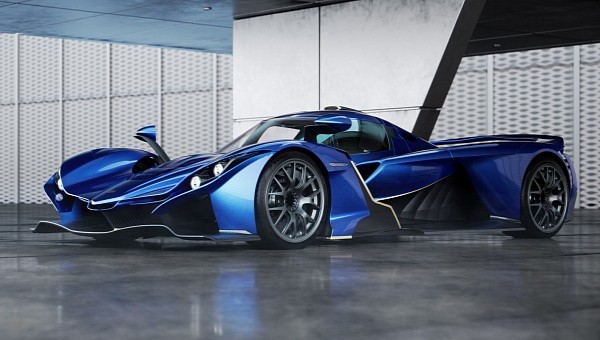Praga is a century-old car company from Central Europe which left the automotive landscape to make way for the Skoda brand in the communist era. After finding success in the race car market in the past decade, Praga is now launching a road-legal, race-inspired hypercar.
You’ll be excused if you know very little about the Praga as a carmaker. Outside of the Anglo-Saxon space, its name sounds like the Czech capital Prague, and for a good reason. The company started in the late 1800s as a heavy industrial manufacturer of everything from bridges to steam trains, and it moved into vehicle production in the early 1900s, making its first car in 1907. Its Praga Alfa car won the “1,000 Miles of Czechoslovakia” road race 89 years ago.
This is the one event that marked the history of Praga, the car company that never was. After finding success in motorsport with the R4S and then the R1 race cars, Praga thought it was time to truly shine with a daring proposition: the Bohema hypercar. The model was inspired by Praga’s R1 and especially by the R1R prototype and will be built in 89 examples to mark the 89th anniversary of Praga’s historic 1933 road race victory.
The Praga Bohema flexes a carbon fiber monocoque for a sub-1,000 kg weight, or 2,200 pounds, an impressive achievement. The mid-engine two-seater is powered by a Nissan GT-R-derived six-cylinder twin-turbo engine, targeting extreme performance on the track while remaining “comfortable and practical for head-turning road trips.”
Praga claims the idea of this hypercar comes from the F1 and currently IndyCar driver Romain Grosjean, who is also Praga’s brand ambassador. Grosjean was actively involved in the development of the Praga Bohema, helping test the hypercar on the challenging six-kilometer (3.7-mile) Slovakia Ring racetrack.
The Nissan-sourced 3.8-liter, twin-turbo V6 engine was modified to deliver 700 horsepower and 725 Nm (535 lb-ft) from 3,000 to 6,000 rpm, although the team that modified the engine can push the design above the 1,000-horsepower mark. The engine sends power to the rear wheels through a Hewland sequential transmission with a robotic clutch allowing for semi-automatic drive mode. The engine and the transmission are mounted independently from the carbon chassis, ensuring annoying resonance and vibrations are not transferred to the cockpit.
The claimed top speed is over 300 kph (186 mph), and the performance is enough to reach GT3 racecar lap times on its semi-slick Pirellis. The aerodynamics put up to 900 kg (1,984 pounds) of downforce to the body when traveling at 250 kph (155 mph). Despite this raw performance, the Bohema remains a comfortable car to drive home from the racetrack, as Praga promises.
The Czech company targets wealthy race aficionados in established hypercar markets such as Australia, Germany, Hong Kong, Japan, South Africa, Spain, Taiwan, UAE, the United Kingdom, and the U.S. Praga aims for a 20-unit Bohema annual production, focusing on quality and attention to detail. Nevertheless, only ten units will be produced in 2023 after production starts at Czech’s Kresta Racing facility. The price is €1.28 million/£1.1 million/$1.33 million, plus taxes.
This is the one event that marked the history of Praga, the car company that never was. After finding success in motorsport with the R4S and then the R1 race cars, Praga thought it was time to truly shine with a daring proposition: the Bohema hypercar. The model was inspired by Praga’s R1 and especially by the R1R prototype and will be built in 89 examples to mark the 89th anniversary of Praga’s historic 1933 road race victory.
The Praga Bohema flexes a carbon fiber monocoque for a sub-1,000 kg weight, or 2,200 pounds, an impressive achievement. The mid-engine two-seater is powered by a Nissan GT-R-derived six-cylinder twin-turbo engine, targeting extreme performance on the track while remaining “comfortable and practical for head-turning road trips.”
Praga claims the idea of this hypercar comes from the F1 and currently IndyCar driver Romain Grosjean, who is also Praga’s brand ambassador. Grosjean was actively involved in the development of the Praga Bohema, helping test the hypercar on the challenging six-kilometer (3.7-mile) Slovakia Ring racetrack.
The Nissan-sourced 3.8-liter, twin-turbo V6 engine was modified to deliver 700 horsepower and 725 Nm (535 lb-ft) from 3,000 to 6,000 rpm, although the team that modified the engine can push the design above the 1,000-horsepower mark. The engine sends power to the rear wheels through a Hewland sequential transmission with a robotic clutch allowing for semi-automatic drive mode. The engine and the transmission are mounted independently from the carbon chassis, ensuring annoying resonance and vibrations are not transferred to the cockpit.
The claimed top speed is over 300 kph (186 mph), and the performance is enough to reach GT3 racecar lap times on its semi-slick Pirellis. The aerodynamics put up to 900 kg (1,984 pounds) of downforce to the body when traveling at 250 kph (155 mph). Despite this raw performance, the Bohema remains a comfortable car to drive home from the racetrack, as Praga promises.
The Czech company targets wealthy race aficionados in established hypercar markets such as Australia, Germany, Hong Kong, Japan, South Africa, Spain, Taiwan, UAE, the United Kingdom, and the U.S. Praga aims for a 20-unit Bohema annual production, focusing on quality and attention to detail. Nevertheless, only ten units will be produced in 2023 after production starts at Czech’s Kresta Racing facility. The price is €1.28 million/£1.1 million/$1.33 million, plus taxes.










